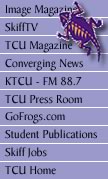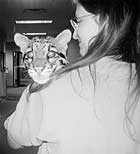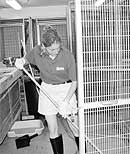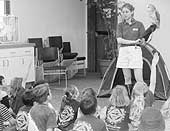
|
Animal
instincts It’s 8 a.m. and Kim Keith is momentarily greeted by the sound of chirping crickets when she arrives at work. Seconds later, the peaceful silence is shattered by a cacophony of hoots, howls, shrieks, squawks, meows and moans.
A jarring way to start the morning for many, but this is just a typical day at the office for Keith. Keith’s charges are sounding off their morning salutations because they know it’s breakfast time, and she’s there to feed them. Tomorrow morning, there will be fewer crickets chirping because some will be the featured entrée today. As she slides off her shoes and slips into calf-high rubber boots and snaps on a pair of latex gloves, Keith, an outreach educator in the Fort Worth Zoo’s Wild Wonders program, said she never thought she would spend her mornings cleaning up animal waste. “It’s not the most glamorous part of the job, but I wouldn’t give up the interaction with the animals for the world,” Keith said. The daily routine of caring for and training the 40 to 50 exotic animals in the program is tedious, but she and her other team members are working toward a much loftier goal. The Wild Wonders program travels throughout the Dallas/Fort Worth area with its “animal ambassadors” to show the beauty of wildlife and encourage people to actively participate in wildlife conservation. “We hope to instill an appreciation for these animals,” Kiersten Anderson, another outreach educator said. “When people learn about and get to see (the animals) up close, they might think twice about not recycling, littering or about any way they can help the wildlife.” Endangered species such as Kanga, a Hyacinth Macaw, and Sky and Storm, nine-month-old clouded leopard cubs are often taken out on tour to illustrate human impact on the environment. Indigenous to the clouded forests of Southeast Asia, the leopard cubs are hunted for their spectacular coats, while Hyacinth Macaws are endangered because of the destruction of their tropical forest habitats. Wild Wonders spreads their message to schools, churches, social organizations such as the Girl Scouts and the Rotary Club, professional associations, day care facilities, and festivals. On May 2, KTCU will air a Wildlife Radio show featuring the Wild Wonders staff and various guests.
Today, the sixth grade class at Meadow Creek Elementary School will meet a black-footed penguin; a leopard cub; a seven-foot Burmese python; a baby American alligator; a tenrec; a binturong, also known as a bear cat, and Madagascar hissing cockroaches. By 11 a.m., the animal room floor is hosed down, and all of the animals have clean cages and full stomachs. Anderson waits outside the zoo’s educational facility classrooms with one of the leopard cubs. Keith enters a training room for the third time this morning, in hopes that Cricket, a wrinkled hornbill, will fly on command. “This job takes a great deal of patience, but it’s incredibly rewarding when an animal finally responds to you,” Keith said. The cub paws at Anderson, and she lifts him into her arms and showers him with kisses with the same tenderness and familiarity as a child. “We’ve bottle fed some of these animals from infancy, so it’s easy to get attached,” Anderson said. “But we know that these are not pets because they are a handful even to trained animal professionals.” Keith said one of the hardest things about the job is the moral quandary of whether or not to keep animals captive. “Occasionally, I see the animals in the cages and wonder how they would be in the wild,” Keith said. “But the animals in this program are trained to be handled by humans and act as spokesmen for animal protection and wildlife conservation.” Anderson carries the cub into a zoo classroom of pre-kindergartners as oohs and ahhs spread across the crowd. Anderson, a former teacher, said the expression on their faces when they see an exotic animal is priceless every time. By 1:15 p.m., the animals are packed into the van with precision and habitual ease and Anderson and Keith are off to Meadow Creek for their final afternoon presentation.
The money made from outreach programs is used in part to fund animal conservation projects. As each animal is presented, students are called up as volunteers. Two boys and a teacher assist in holding the python stretched out to its full length. One terrified-looking girl gingerly strokes a baby alligator at an arm’s length. Two boys stand paralyzed while enormous cockroaches crawl on their shirts, and another boy is invited to smell the musty, burnt popcorn scent of the binturong’s fur. A penguin waddles through the aisles, and a hawk flies on command over their heads. “Kids often think of the program as a rare treat,” Anderson said. “It’s really an opportunity to see something that they don’t soon forget.” At the end of the day, the cages are tidied and some animals get their afternoon meals. “My hair smells like popcorn after the binturong crawled all around my head all afternoon,” Keith said. “I can’t wait to get home a take a long hot shower.” Elise
Rambaud |
|||||||
|
TCU Daily Skiff © 2002 |
||||||||




